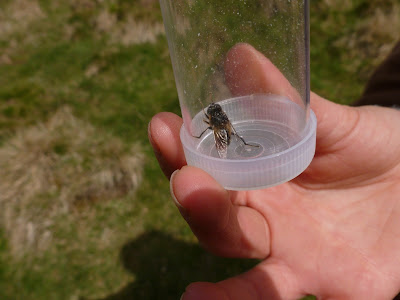Today we joined the Avon Wildlife Trust volunteers for a bumblebee ID course guided by the Bumblebee Conservation Trust.
First things first, let's place the location!
First things first, let's place the location!
The course was organised at the Folly Farm Centre, located in the Chew Valley just 40 minutes outside of Bristol. The Farm is owned by the Trust and its wildflower meadows and woodlands are Sites of Scientific Interest (SSSI). Unspoilt by pesticides and fertilizers the meadows are covered in ant hills, wild grasses and tussocks, perfect for bumblebees and solitary bees! The weather was on our side as well, with bright sunshine and only sporadic gusts of wind!
We arrived at Folly Farm in the morning where, sitting on bails of hay, we started with a general presentation on bees and a quick overview of the main project carried out by the Bumblebee Conservation Trust: Bees for Everyone. The project aims to counteract the current decline of many bumblebee species due to habitat loss as well as raise awareness with the public. Nine out of the 24 bumblebee species present in the UK are declining due to habitat loss; among these are the Shrill Carder Bumblebee (Bumbus sylvarum), identified by its striking high-pitch buzz, and the Great Yellow Bumblebee (B. distinguendus). The Red-shanked Carder Bumblebee (B. ruderarius), Moss Carder Bumblebee (B. muscorum), and the Brown Banded Carder Bumblebee (B. humilis) are also rarer species to look out for.
 |
| Jo Chesworth (Senior Conservation Officer with the Bumblebee Conservation Trust) led the day and is seen here giving us a presentation on the trust and how to ID the six most common bumblebees. |
After biscuits and tea we got a brief course on how to spot and recognize the most common six species, as well as distinguish females (pollen baskets present on hind legs) from males (pollen baskets absent). Most bumblebees seen foraging will be workers who are females; males, on the other hand, once out of the nest never go back and will spend their time lazily sitting on flowers and sipping nectar. Sometimes you can spot them sleeping under a leaf or a flower head!
 |
| Just in case the weather was too bad to find any bumblebees these were brought along to ID in a emergency. Luckily they weren't needed! |
After all the theory and a good lunch this is what we found out in the field:
 |
| The first catch of the day was hoverfly, not what we were after but a good start none the less. |
 |
| The first bumblebee of the day being identified by Jo. |
 |
It turned out to be a buff-tailed bumblebee (Bombus terrestris) queen......looking slightly flattened but it flew happily away afterwards so none the worse for it!
|
For more information about the work carried out by the Trust and on how to spot a rare bumble bee visit: http://bumblebeeconservation.org/.
During our escapade at Folly Farm we learnt that Bumblebee queens are attracted to the smell of mice borrows where they like to nest. So if you happen to have old mice borrows in your garden think twice before getting rid of them!
We also learnt that artificial nests also exist for bumblebees - they are boxes that can be placed below ground. However having a box is not enough to get a buzzing garden, you still need to attract them to it... location is of course essential! Rusty from Washington has some tips for people who might own one and are desolated by its emptiness:
An example of great nesting habitat for bumblebees are the Folly Farm meadows which are full of tussock grass and ant hills...
One Buff Tailed Bumblebe (B. terrestris) queen
we found was completely covered in large red/pink mites about 2mm long. They
were all over her thorax, although the queen seemed to be unaffected by the
alien presence. Back in the office we searched the web about the effect of
these mites on bumblebees!
From Ted Benton’s book Bumblebees (New Naturalist series):
"Most [mites] are believed to be harmless commensals
[i.e. they just live alongside the bees, not affecting them], and there is even
some evidence that they may be beneficial, as they consume moulds and detritus
in the nest. However, there is also the possibility that they may act as
vectors for virulent microorganisms."
It looks like the mites we saw were probably just 'hitching
a lift' on the bumblebee!





No comments:
Post a Comment